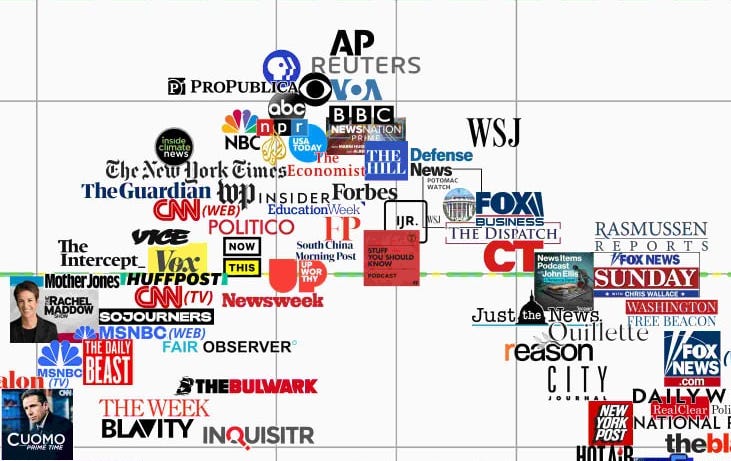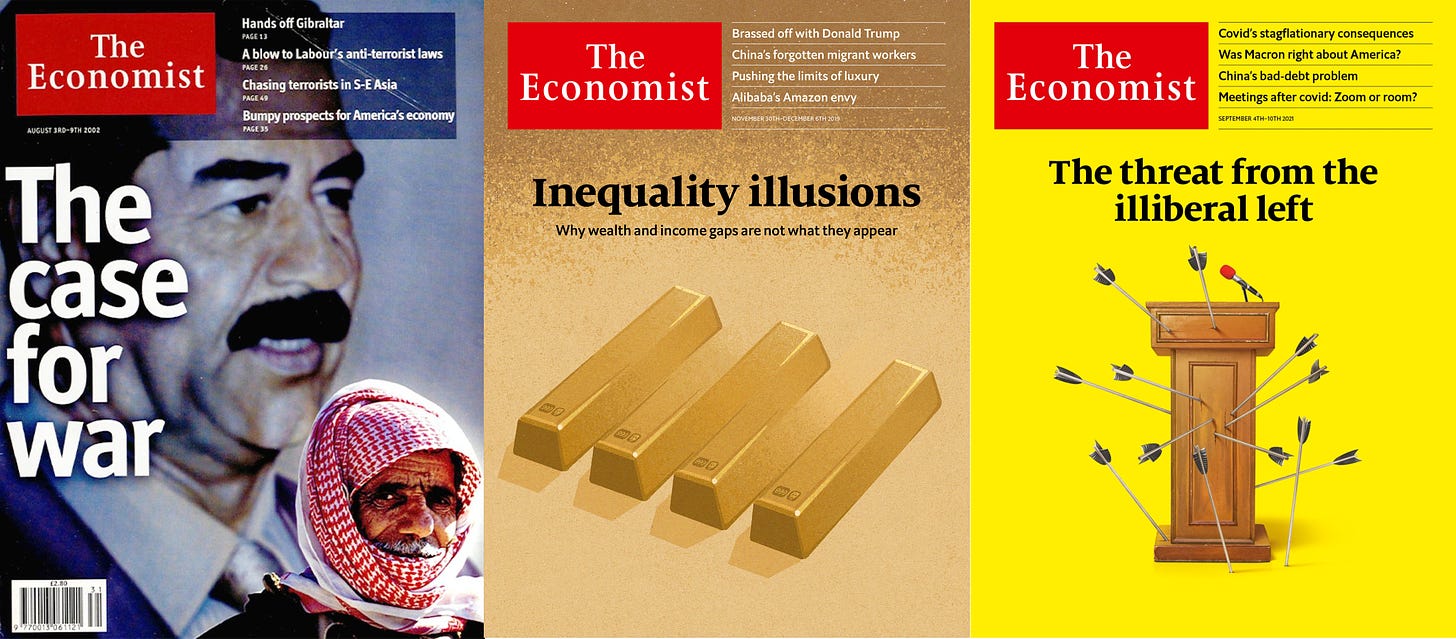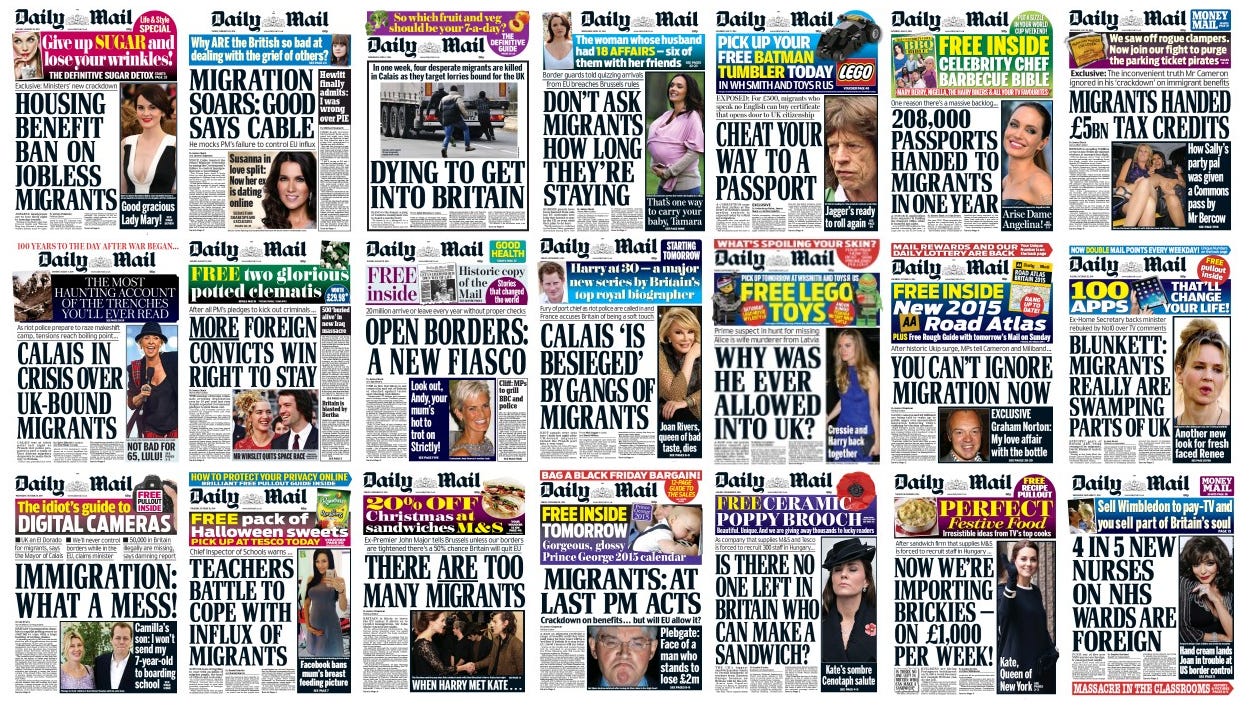The Media Bias Chart's liberal bias
It's time we started realizing that the centrist-leaning liberal media is not nearly as unbiased and reliable as they've made themselves to be
What do online firebrands Jimmy Dore and Charlie Kirk have in common? They are both included in the latest edition (8.0) of the Media Chart Bias which has expanded its reach from traditional media outlets (television and internet journalism) to the increasingly popular YouTube and podcast punditry space. Alas, for all its efforts at capturing the political inclinations of these kids on the media block, the MCB still falls pray to its inherent flaws which actually made it a rather poor tool for assessing the media’s ideological bias and truthfulness.
The MCB is the brainchild of Vanessa Otero, a patent lawyer, who later founded Ad Fontes Media to continue developing it following its viral success in 2016. It is something of a product of the early Trump-era obsession with fake news as well as the need to categorize the new internet-only media that had emerged over the past two decades, some of which was increasingly influential to anyone old enough to recall how The Drudge Report was the go-to site for conservative scoop during the Bush era. The MBC categorizes media outlets on two factors: their ideological bias as well as their reliability, the latter referring to the proportion of content that was factual news reporting compared to persuasive opinion writing. The result of the initial chart, as well as every updated version since, has been a neat arch with the most centrist leaning sites also being the highest in terms of reliability, the latter which would drop the farther one drifted towards the two ideological extremes.
Conceptual limitations
There are two major limitations of the chart’s inherent design which severely impair the veracity of what they intend to convey. The first, of course, is the center that it claims belongs to “unbiased” media is far from being so. Although the chart includes some UK-based media, it is entirely US-focused and its center ground is based not on the actual policies that the media endorses but rather, their partisan leanings. This is obviously problematic since the Democratic Party is by no stretch of the imagination a left-wing party (at least its establishment base) given its opposition to nearly every economic and national security policy that say, a European left-wing party would support. Centrism, in the US, is decidedly right-leaning and this includes most of the liberal media like CNN, MSNBC, The New York Times, and The Washington Post. However, the MBC puts them left of center where only on social issues they can reliably belong (and in many cases only performatively).
The other, and arguably more problematic, issue with the MBC is the uncomfortably strong correlation between bias and reliability which has no theoretical reason for existing. In fact, is very much possible to avoid having an op-ed or commentary page and still be enormously opinionated merely on the basis of the news you choose to cover and the news you choose to ignore. You can also hide the scale of your persuasiveness by incorporating opinion into the news coverage itself rather than rely on an op-ed page, something that The Economist does to give itself an aura of authoritativeness. Vox, which introduced the ‘explain-y’ style of journalism that is now quite popular with liberal centrists, also tends to hide its very strong Democratic establishment bias through its dry and dispassionate writing. The flip side is that your reporting can also be tremendously politicized and still be highly reliable, as it the case with The Intercept whose quality of investigative journalism tends to shame that of most of the outlets that score higher on reliability.
Poor research
The third major flaw is not so much inherent as it is simply shoddy research. Ironically, this was not always the case: Otero’s initial iteration of the MBC had much less to criticize in terms of the placements of the main outlets, of which there were only a fraction compared to later version. Notably, it did not measure reliability so much as it did the complexity of its writing, with the lowest rankings having comically colloquial descriptors like “Basic AF”. Separating complexity from truthfulness is not mere semantics. Nobody doubts that outlets like The Economist, Vox, and The Atlantic have much more sophisticated writing and cover more complex topics independently of how much of it is laced with their own ideological persuasions. Otero also had the common sense of manually clustering the outlets inside pre-defined areas (rather than the other way around), and it is clear she had less regard for many of the outlets that subsequent iterations ranked highest. CNN, for example, was put nearly at the bottom in the area known as “better than no news at all”.
Unfortunately, it’s been all downhill from there. For example, the 3.0 edition from 2017 had Democracy Now!, arguably the biggest left anti-war site, as well as Jacobin, an overtly socialist magazine, only a few pixels to the left of the centrist Vox and MSNBC. Likewise, The Guardian was put exactly on the same center-left bias scale as the NYT and WaPo despite being clearly more to the left than its two US counterparts. At least that edition had The Economist more correctly in the center-right and both CNN and MSNBC at rather embarrassing levels of reliability for mainstream cable networks. These positions better reflect the poverty of their Trump-era coverage, with every day being a litany of ‘Orange Man (Trump) Bad’ segments to say nothing of the obsession with Russiagate by some of their leading anchors like Rachel Maddow. Still, one cannot help but see the MBC as being more concerned about preserving form (ensuring the outlets fit its imaginary ‘arch’) over function.
Ignoring for a moment its YouTubers and podcasters (which before the 8.0 edition were ranked in a separate podcast bias chart), the newest MBC does little to correct the flaws it has carried over the years. One of its most inexplicable inclusions is that of The Daily Mail, which is by far Britain’s most right-wing newspaper (and the one that every British racist and Brexiteer reads religiously), yet is placed as barely right of center. The Rachel Maddow Show, whose quality of journalism has only appeared to improve because Russiagate is no longer a talking point, remains just slightly below The Intercept in reliability despite the latter breaking some of the most important stories in recent years. Tucker Carlson, who flirts with white supremacy more than any other Fox host is somehow less to the right than his colleague Sean Hannity. And to top it off, alt-right conspiracist darling Breitbart News is somehow both less biased and more reliable than either. Nothing adds up.
Enter the new kids
If the MBC’s mischaracterization of mainstream media outlets is bad enough, there would be little reason to suspect that its inclusion of the YouTube and podcast scenes would be any better. In that respect, it did not disappoint. On the left, there is the strange inclusion of The Grayzone, a Putin- and Assad-loving ‘anti-war’ outfit with possibly the most selective and biased takes on US foreign policy imaginable, yet still considered marginally reliable. Inexplicably, it appears to the right of The Young Turks, a moderate progressive online news channel, and Pod Save America, hosted by ex-Obama staffers and pretty much as dyed in the wool centrist as you can get. And hugging the left edge is Chapo Trap House and The Jimmy Dore Show. While Chapo is known for its edginess and irreverence, Jimmy Dore is famous for its anti-establishment hysterics to the point it is even questionable whether he is a leftist at all (Dore, tellingly, is a regular on Tucker Carlson’s show).
The new inclusions on the right have equally dubious positions. The MBC is far too gracious for openly reactionary sites like The Daily Wire and PragerU, the latter which has no news content whatsoever but is placed next to Fox News itself. Quillette, an Australian alt-lite site is even higher up, nearly at the same reliability level of Newsweek and The Daily Beast despite its sole news coverage limited to anytime a Nazi is barred from speaking at a college campus or other anti-woke clickbait. Once again, you can’t look at this chart and not get the feeling that the priority was to fit all these channels into the arch although at least there is some recognition that the most right-wing channels, which are now little more than QAnon and anti-woke propaganda, are far less reliable than their extreme left-wing equivalents.
A media bias chart… with liberal centrist bias
“The mass media serve as a system for communicating messages and symbols to the general populace. It is their function to amuse, entertain, and inform, and to inculcate individuals with the values, beliefs, and codes of behavior that will integrate them into the institutional structures of the larger society. In a world of concentrated wealth and major conflicts of class interest, to fulfill this role requires systematic propaganda.”
- Edward S. Herman and Noam Chomsky, Manufacturing Consent (1988)
In a nutshell, the salient problem with the Media Bias Chart is that it is itself extraordinarily biased because fits a narrative for journalistic quality based on liberal media standards. It makes people like Thomas Friedman, the perennially wrong NYT commentator who is little more than a mouthpiece for establishment interests, feel good about himself for writing for a reliable, “left-of-center” publication. Which in reality has nothing leftist about it and is not nearly as factually reliable as it presumes to be, as Friedman’s content consistently demonstrates.
Nowhere is this more evident than on foreign policy. Nearly all the liberal media that the MBC categorizes as left-leaning supported the Iraq War (CNN, MSNBC, NYT, WaPo, The Economist all guilty on this front) or sold it to their audiences though daily hawkish op-eds and interviews with national security “experts” touting the case for war. Anyone thinking much has changed since 2003 should be reminded of how these same outlets ridiculed Biden’s withdrawal from Afghanistan, often through the opinions of the same neo-con warmongers whose careers in journalism they have helped revitalize over the past two decades (David Frum now writes for The Atlantic, Jennifer Rubin for the WaPo, Bret Stephens for the NYT, etc.).
From a normative perspective, the MBC appears to serve the purpose of nudging people towards this imaginary center by brandishing the extremes as unreliable. Yet our increasing awareness of the politization of the media has produced the opposite effect and it’s mostly been the liberal media which has suffered as a result: for example, both CNN/MSNBC’s ratings have plummeted post-election far more than Fox News has in the absence of ‘Orange Man Bad’ hysterics. This would seem to suggest that people actually prefer media that presents their content pre-packaged with an ideological bias. Ultimately, media bias charts like these ultimate perpetrate the biggest myth of them all: the myth of the perfectly rational, homo economicus-like individual. The myth that people being made aware of their supposed biases will want to get rid of them rather than find the echo chambers to nurture them.
Whether in the longer run this polarization of media consumption helps or hurts democracy is a question that remains to be answered. As it stands, the supposedly unbiased and fact-based center-leaning media is hardly helping given their tepid support for the policies that would make US political life less radicalized (i.e., causes that help working people rather than business interests). In the meantime, charts like the MBC serve a single purpose. To make consumers of liberal media fool themselves into thinking their status quo-approved views emerged victorious in the marketplace of ideas, and not that they too have been brainwashed into them.
Did you like this article? Follow me on Twitter at @raguileramx and on YouTube at ProgressumTV. You might also like my book, The Glass-Half Empty: Debunking the Myth of Progress in the Twenty-First Century (Repeater Books, 2020).






